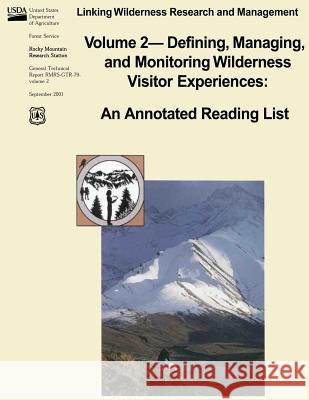Linking Wilderness Research and Management: Volume 2 - Defining, Managing, and Monitoring Wilderness Visitor Experiences: An Annotated Reading List » książka
Linking Wilderness Research and Management: Volume 2 - Defining, Managing, and Monitoring Wilderness Visitor Experiences: An Annotated Reading List
ISBN-13: 9781480172401 / Angielski / Miękka / 2012 / 40 str.
Linking Wilderness Research and Management: Volume 2 - Defining, Managing, and Monitoring Wilderness Visitor Experiences: An Annotated Reading List
ISBN-13: 9781480172401 / Angielski / Miękka / 2012 / 40 str.
(netto: 53,18 VAT: 5%)
Najniższa cena z 30 dni: 55,68
ok. 16-18 dni roboczych
Dostawa w 2026 r.
Darmowa dostawa!
The 1964 Wilderness Act calls for ..".an enduring resource of wilderness...for the use and enjoyment of the American people" and lists among the attributes of wilderness "outstanding opportunities for solitude or a primitive and unconfined type of recreation." These statements confirm experiential opportunities as one of the primary purposes of wilderness. Furthermore, by signing the act into law, Congress declared that wilderness experiences are so important they are worthy of protection by national legislation. Wilderness experiences have been credited with everything from personal psychological benefits to formation of the national character. Heavy or growing use levels at many wilderness areas are proof that the public increasingly values the opportunity to experience wilderness firsthand. In response to the fear that increasing use would threaten the experiential qualities of wilderness and wildlands, researchers with training in sociology, psychology, and anthropology began a focused program of outdoor recreation research in the 1960s. Although the initial focus was on determining objective visitor "carrying capacities" for protected areas, scientists soon found that the relationship between use numbers and wilderness visitor experiences is extremely complex. This research expanded to address the values that people hold for wilderness (including nonrecreation values), the types and dimensions of wilderness experiences, and factors that influence those experiences. Simultaneously, managers and scientists worked together to develop techniques and long-term planning frameworks to ensure that quality wilderness experiences continue to be available. Whereas early wilderness stewards had few resources other than instinct and personal experience to guide them, managers today have access to a significant body of literature related to defining, managing, and monitoring wilderness experiences. In fact, the volume of available information can be confusing or even overwhelming. This reading list gathers together and organizes a representative sample of this information in a way that we hope will be useful to both managers and researchers.
Zawartość książki może nie spełniać oczekiwań – reklamacje nie obejmują treści, która mogła nie być redakcyjnie ani merytorycznie opracowana.











